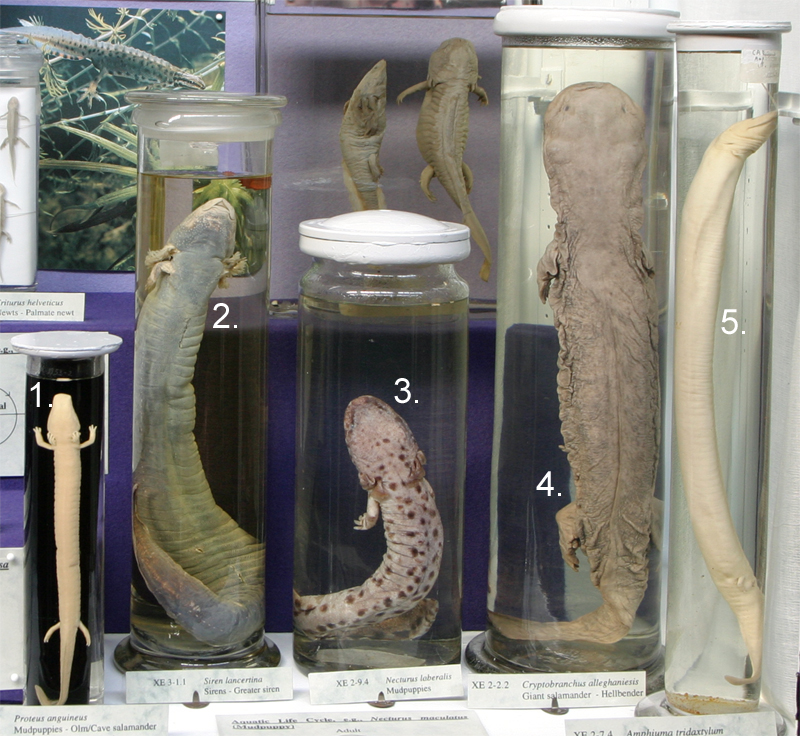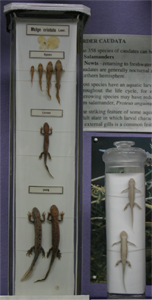
ORDER CAUDATA
The 358 species belonging to the order Caudata can be generally divided into newts and salamanders. These animals are normally nocturnal and found in cool, shady habitats in the Northern Hemisphere. Some caudates are amphibious, others are entirely aquatic, yet others are entirely terrestrial and some burrow. Aquatic or burrowing species may have reduced or rudimentary limbs. Caudates are restricted to damp or wet habitats because their skin acts as a respiratory organ through which oxygen enters the body. All are carnivorous.
Newts differ from salamanders in that adult newts are always terrestrial, returning to water only to breed in spring; larvae develop in water and then emerge onto land until mature and ready to breed in their turn. Salamanders have very diverse range of life cycles and many families are normally paedomorphic – adults retaining larval features, that may be more or less visible from the exterior.
SALAMANDERS
The many families of salamanders show diverse life cycles: some are amphibious, others terrestrial, other wholly aquatic. Most species belonging to the family Salamandridae (Newts, Fire and Brook Salamanders) normally develop from larvae into a fully sexually mature adult. In one species of mole salamander (family Ambystomatidae), some populations of axolotls exhibit paedomorphosis. In some families of salamanders, paedomorphosis is normal and adults always retain some larva features.
Family Ambystomatidae Right: Larvae (left) and Adult (right) Mole Salamander, Ambystoma species. All species of the Northern American mole salamanders (family Ambystomatidae), except one, have a similar life cycle. They live in burrows on land for much of their lives, moving to ponds to mate, their larvae are aquatic. In certain populations of one species, Ambystoma mexicanum, that lives in Mexico, the adults are paedomorphic remaining in the larval form, with external gills, even when sexually mature. This example of paedomorphosis is attributed either to there being insufficient iodine in the waters the axolotls inhabit for them to produce the thryroxine needed to trigger metamorphosis, or to the temperature of the waters they inhabit being too low for thyroxine to work. If injected with thyroxine, the paedomorphic larvae will mature and lose their larval features. |
 |
PAEDOMORPHIC SPECIES OF SALAMANDER
Members of some other families of salamanders of which we have adult specimens are normally paedomorphic. In these species, all adults retain larval characteristics. Some may be obvious – the external gills of the mudpuppy, the olm and Greater siren. In the hellbender, a giant salamander, and the amphiumas, larval features are still present but less obvious. Injecting thyroxine into adults of these species does not induce the loss of larval features. The retention of gills through out life is most common in species living in stagnant water poor in oxygen.

1. Proteus anguinus(Family Proteidae). The olm or cave salamander (vulnerable species status) lives in muddy or stagnant water in localized caves in Eastern Europe and Northern Italy. It lacks eyes, has external gills and four spindly legs.
2. Siren lacertina (Family Sirenidae). The Greater siren lives permanently in muddy pools in Central and Eastern Northern America. It has gills, front legs but no hind limbs.
3. Necturus maculosus (Family Proteidae), a type of mudpuppy. Mudpuppies live in ponds, lakes and streams in Eastern and Central Northern America. They have four legs and gills. The size of the gills depends upon levels of oxygen in the water - gills are larger where oxygen levels are poorer. These salamanders are called puppies due to the mistaken idea that they produce a noise like a bark.
4. Cryptobranchus alleghaniesis(Family Cryptobranchidae). The North American giant salamander or Hellbender lives in rivers and large streams. Its large size (up to 70 cm) and lack of gills probably restricts it to flowing water where oxygen levels are high.
5. Amphiuma tridactylum(Family Amphiumidae). The adult three-toed amphiuma has lungs. It loses its gills but retains an open gill slit, a larval feature. Amphiumas live in stagnant waters and swamps in South Eastern North America; they are active at night spending much of the day time in their burrows.








